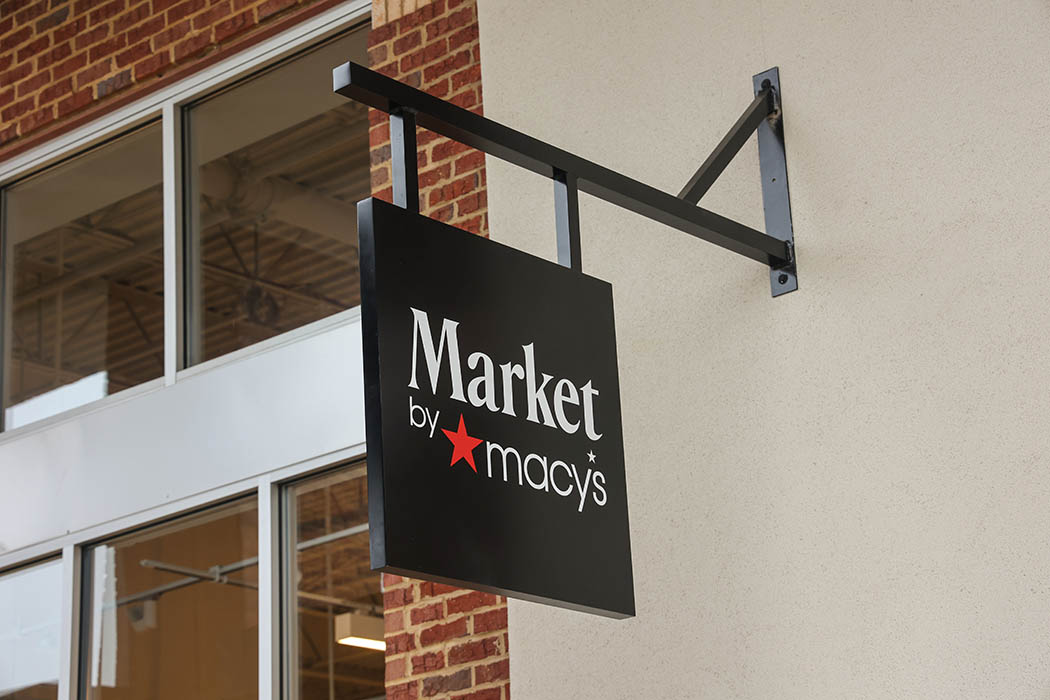— By Katie Lee —
To meet today’s retail consumers where they are, Macy’s offers a new smaller store format, expanded digital conveniences, and sustainable operations.
Macy’s, the venerable New York-based department store chain we all know and love, is more than its storied 150-year history, more than its omnipresence in malls all over America, more than its countless Christmas tree lightings and Thanksgiving Day parades in New York and The Miracle on 34th Street movie. It’s a steady leader during unsteady times, an agent of change in a fast-changing retail world.

Macy’s celebrates the grand opening of the Market by Macy’s in Johns Creek Town Center on August 19, 2022 in Suwanee, Ga. (Phil Skinner/AP Images for Macy’s)
Leading the way for traditional, mall-based department stores everywhere, Macy’s recognized where the consumer trends were heading even before the pandemic accelerated them. Prior to 2020, Macy’s was already navigating toward this new tomorrow — ‘Polaris’ strategy, it was called — designing a smaller-format version of its store, independent of malls and nestled in neighborhoods. Macy’s wanted to meet customers where they are, closer to their homes, with convenience top of mind. The new store concept, which first opened in early 2020, was called Market by Macy’s.
With a smaller store that offers a curated assortment of the latest fashion trends, Macy’s hoped to reposition its physical store footprint to better serve local, convenience-minded customers and, at the same time, support omnichannel market sales growth. It’s a synergistic win-win: the off-mall, small format advances the strategic vision of the company’s overall omnichannel retail brand building and the elevation of the customer experience — both in-store and across digital platforms.
To elevate its digital side, Macy’s created a seamlessly connected, tech-enabled “omni-ecosystem” across its 500+ store fleet. After all, as the U.S. emerges from 2.5 years of the COVID-19 pandemic, retail consumers conduct more of their shopping online than ever before. But the company also realized that brick-and-mortar stores will continue to play an important role in its brand evolution. It will just be more selective about where — and what size — those stores are.

Joy Salvador
We know that a combination of physical stores in the best malls to the most productive off-mall locations and a best-in-class e-commerce platform is how we will win,” says Joy Salvador, senior director of strategy and new store format, Macy’s Inc. “And, it’s how we meet customers whenever, wherever and however they choose to shop.”
Throughout fall 2022, Macy’s will open four new off-mall, small-format stores. The locations will include Market by Macy’s as well as the first-ever dual Market by Macy’s and Macy’s Backstage off-price location. Macy’s is currently in planning stages to add additional locations off-mall in 2023.
Although it’s a smaller space, Market by Macy’s will still carry private brands — such as INC International Concepts, Bar III and Hotel Collection — and will also features Macy’s newest private brands, which includes And Now This, elevated basics and sophisticated pieces for the fashion-forward customer; and Oake, a mindfully made home collection that includes bedding, bath accessories and décor.
“The assortment cannot be found in any other competitor,” Salvador says. “These collections and additional vendors, including Finish Line and Sunglass Hut, are curated for each location.”

Macy’s celebrates the grand opening of the Market by Macy’s in Johns Creek Town Center on Friday, August 19, 2022 in Suwanee, GA. (Phil Skinner/AP Images for Macy’s)
The smaller format is focused on providing a convenient and seamless shopping experience to Macy’s customers in high-traffic centers and has brought in new customers who are engaging with its curated selection of brands and products.
The stores feature an open environment where all merchandise is easily accessible on the floor in a full-service shopping environment. The stand-alone stores will range in size from 30,000 to 58,000 square feet; by contrast, a full-line Macy’s store usually spans 160,000 square feet, attached to a mall.
In 2020, the first Market by Macy’s opened in the Dallas-Fort Worth area at Southlake. In 2021, four new stores were introduced: Presidential Markets and South Point in the Atlanta metro area, and WestBend and Highlands at Flower Mound in the Dallas-Fort Worth area. In fall 2022, Macy’s opened its third Market by Macy’s in the metro Atlanta area at John’s Creek. The company will open its first dual Market by Macy’s and Macy’s Backstage location at Evergreen Plaza in the Chicagoland area, and it will open an additional Market by Macy’s location at Chesterfield Commons in the greater St. Louis area.

(Phil Skinner/AP Images for Macy’s)
All of which brings the total number of Market by Macy’s stores to 8. This is a part of the previously announced 5-6 off-mall locations expected to open in 2022, which will include a mix of Market by Macy’s, freestanding Backstage, Bloomie’s and Bloomingdale’s The Outlet locations.
So far, as Macy’s tests the new look in different markets, customers love what they see.
“The Market by Macy’s response has overwhelmingly been positive,” Salvador says. “New customers find the store location near their homes to be a huge win, the layout super easy to shop and our colleagues to be very friendly and engaging. Long time Macy’s shoppers like the convenience of a store in their neighborhood that allows them to pick up online orders or make a return versus having to drive 20 or more minutes to a mall-based store.”
Customer convenience today is key — and Market by Macy’s delivers on that promise. Customers can pay their bill or pick up Macys.com orders, buy gift cards, return and exchange merchandise from the ‘At Your Service’ desk, a dedicated location inside the store for seamless online pickups and returns. Curbside service is yet another effort to make customers’ lives as simple as possible. The company also has modernized its mobile app, making it easier for customers to shop their personal style, check prices in-store, build favorites lists, manage their star rewards and track orders. Last but not least, Macy’s has a growing partnership with DoorDash, which has now expanded to offer same-day delivery to nearly every market across the country.

(Phil Skinner/AP Images for Macy’s)
The new Market by Macy’s concept as well as the company’s elevated digital offerings build upon an existing partnership with Toys“R”Us. Partnering with Toys“R”Us since August 2021 has also elevated the digital shopping experience, bringing additional brand names to the Macy’s platform and providing an opportunity to curate an online and in-store experience for customers.
“We are so excited to see the experiential shop installations going into all stores as we head into this holiday season,” Salvador says.
In addition to the expanding its Toys“R”Us partnership, Macy’s is growing its off-price, on-trend concept called Macy’s Backstage. Macy’s currently operates more than 300 store-within-store Backstage locations and 10 freestanding locations. Backstage offers an assortment of current fashion trends as well as its own distinct product categories. The merchandise assortment is a combination of overstock from other stores, deals from vendors and new connections in the marketplace.
“Evergreen Plaza [near Chicago] is the first dual concept that will have a Market by Macy’s on the first floor and Backstage on the second,” Salvador says. “We’re excited to see how the combination of these two smaller-concept stores is received by our customers.
As with smaller formats and dual or off-price concepts, customer expectation drives so much of the decision-making in today’s retail industry. And today’s retail customers expect not only convenience, but also sustainability and environmental responsibility from the stores in which they shop.
In 2018, Macy’s introduced several sustainable stewardship goals to be achieved by 2025, including reducing energy consumption by 10% and increasing its in-store recycling rate to 80%.

(Phil Skinner/AP Images for Macy’s)
Macy’s greatest opportunity for energy reduction continues to be lighting. Since 2010, Macy’s has reduced total energy consumption by more than 17.8% through LED lighting retrofits. The company has more than 100 active solar sites nationwide and approximately 65 million kWh was produced in 2020, offsetting 46,000 metric tons of CO2e.
“Our policy at Macy’s is to recycle as much material as possible, including cardboard, plastic film, hangers, metal fixers and wooden pallets,” Salvador says. “This strategy spans across our stores, corporate offices and distribution centers.”
Additionally, Macy’s has adopted best practices to reduce product packaging, including standardizing the size of packing cartons and minimizing packaging materials. Lastly, Macy’s has partnered with Volta to offer free electric vehicle (EV) charging at 37 of its locations.
Proving once more that it can define a generation as well as lead the next one, Macy’s Inc. has created a compelling new store format driven by evolving customer expectations, continues to elevate its digital experience to engage post-COVID shoppers, and is also going green — all at the same time.
— This article originally published as the cover story of the October 2022 issue of Retail & Restaurant Facility Business magazine. Email the editor, Katie Lee, at [email protected].

